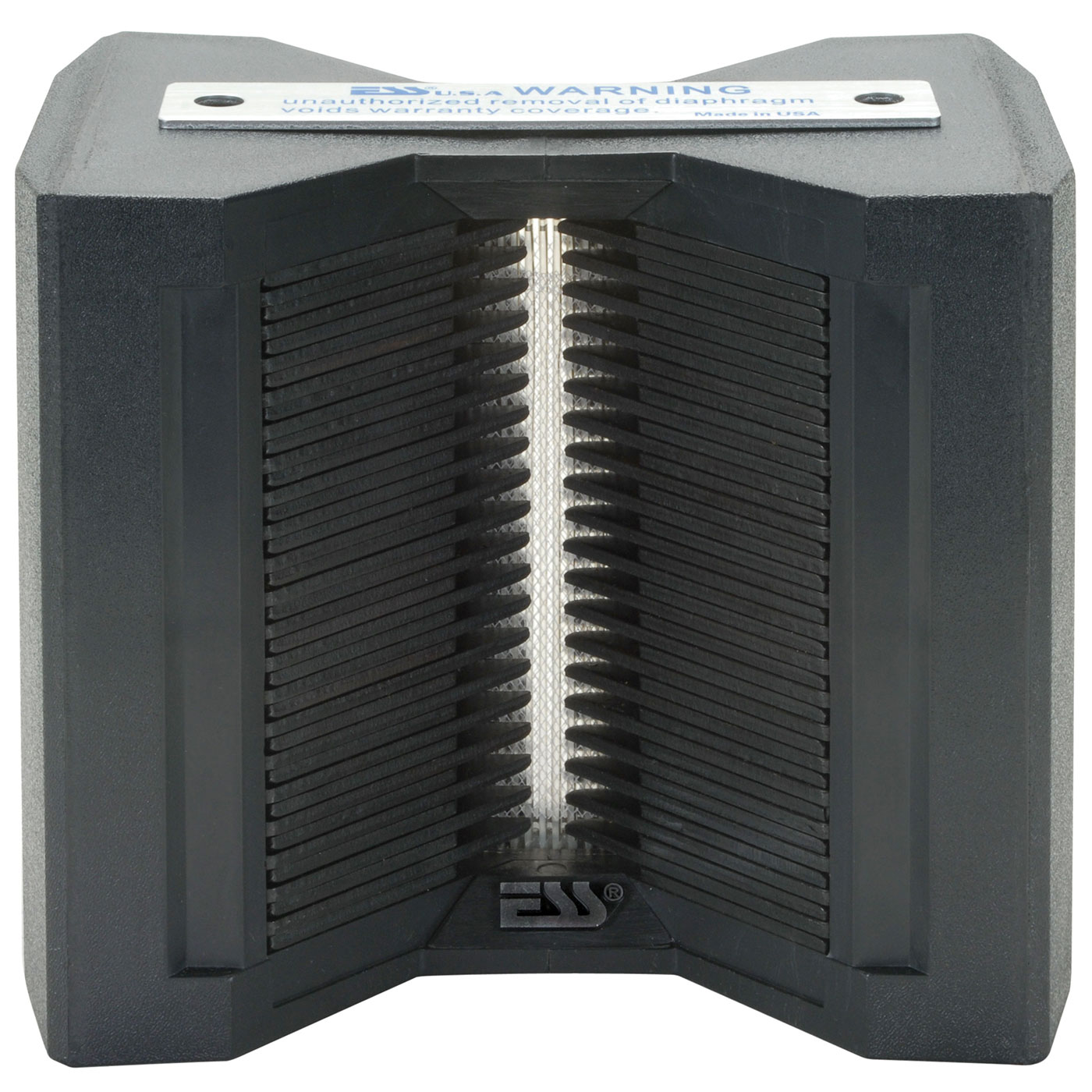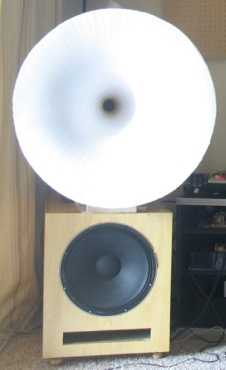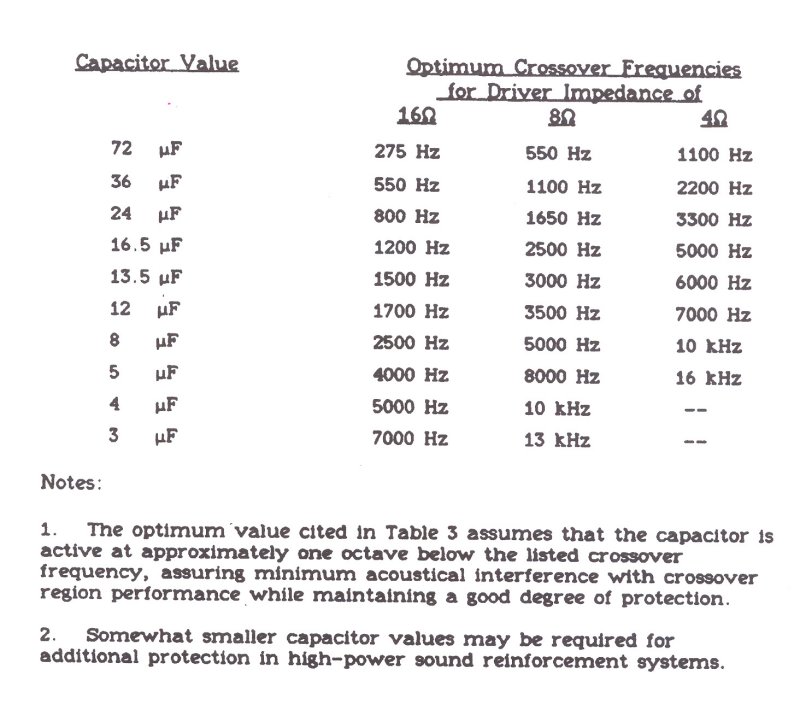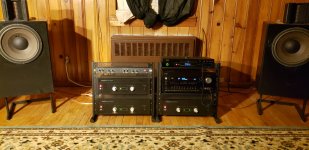You can still get both the whole driver, as well as replacement membranes for them.I have a pair of these laying around, not sure if the membrane is still intact:

Parts | ESS Laboratories, LLC
I got a pair when they had a sale on around christmas. At $140 pr, it was a steal...
The only thing against the Heil for the OP, is that the Heil has quite a bit less sensitivity than the Beyma. On the other hand, it will cross over a bit lower.
Johan-Kr
$140 each.$140 for a pair? That's a hell of a deal.
With a pair of 12 or 10", you could build a nice 2 way for little money.
Considering and collecting parts. Thinking of a FaitalPro 8-10" mid and double 12" woofers. I’ll go for hifi subwoofers, instead of pro woofers, to get sub 20Hz response and small enough enclosure to keep SAF at a high enough level.
I already have a Hypex DLCP an a 6ch UcD amp.
Johan-Kr
Ro808, thanks for your help thus far, in regards to the horn selection. Two things that are true with eq, always cut when you can vs boost, and, the less eq needed to reach target curve, the better. So I am interested in the potentially flatter frequency response of the tractrix horn. Not to say that, for example, a SEOS horn can’t result in a flat response after eq but, which ever horn can result in the flattest response, pre eq, is likely to hold my attention
Thinking of a FaitalPro 8-10" mid and double 12" woofers. I’ll go for hifi subwoofers, instead of pro woofers, to get sub 20Hz response and small enough enclosure to keep SAF at a high enough level.
That's what I did. I used a pair of JBL 121A drivers used in the original ultrabass module in the L212 system. Got an f3 of 27Hz in a 2.2 cubic ft box. in room solid to below 25hz. They are biamped with a passive notch filter.
Rob
Attachments
Camplo, sorry I might have missed some parts of this thread, but have you planned already how to locate and position the speakers and what kind of sweet spot you need and what kind of acoustic treatment there is? I mean, flat frequency response on axis or in the intended listening axis? The horn affects on which angle the flat frequency response and how smooth directivity index there is. All this is from Geddes and his thoughts make sense ( to me  . Toe in the speakers to delay first reflections and design the speaker response to be best on the listening axis.
. Toe in the speakers to delay first reflections and design the speaker response to be best on the listening axis.
Not sure if its at all relevant for your studio environment but I think it is important to at least think about the listening axis and directivity index before selecting a waveguide if you want exceptional sound in your room.
Here is something about it Geddes on Waveguides and a lot more if you search.
Not sure if its at all relevant for your studio environment but I think it is important to at least think about the listening axis and directivity index before selecting a waveguide if you want exceptional sound in your room.
Here is something about it Geddes on Waveguides and a lot more if you search.
Last edited:
$140 each.
Considering and collecting parts. Thinking of a FaitalPro 8-10" mid and double 12" woofers. I’ll go for hifi subwoofers, instead of pro woofers, to get sub 20Hz response and small enough enclosure to keep SAF at a high enough level.
I already have a Hypex DLCP an a 6ch UcD amp.
Johan-Kr
Faital makes excellent drivers.
I will listen to a bunch of those shortly.
However, thinking of ESS, a manufacturer specialized in AMT drivers, I was immediately reminded of a manufacturer specialized in woofers: PHL.
The PHL 3002 in a 80l cab tuned to around 30Hz with the ESS on top would enable 30-30000Hz.
Member Lindell used the PHL with a Beyma Compression driver and horn.
Ro808, thanks for your help thus far, in regards to the horn selection. Two things that are true with eq, always cut when you can vs boost, and, the less eq needed to reach target curve, the better. So I am interested in the potentially flatter frequency response of the tractrix horn. Not to say that, for example, a SEOS horn can’t result in a flat response after eq but, which ever horn can result in the flattest response, pre eq, is likely to hold my attention
You're right, if directivity isn't on the list of priorities.
I am sure you'll manage to achieve your goals with the Tractrix, which would require cutting before boosting.
Last edited:
This subjective comparison between an Inlow Tractrix versus other types of loudspeakers is enlightening.


Last edited:
Camplo, sorry I might have missed some parts of this thread, but have you planned already how to locate and position the speakers and what kind of sweet spot you need and what kind of acoustic treatment there is? I mean, flat frequency response on axis or in the intended listening axis? The horn affects on which angle the flat frequency response and how smooth directivity index there is. All this is from Geddes and his thoughts make sense ( to me. Toe in the speakers to delay first reflections and design the speaker response to be best on the listening axis.
Not sure if its at all relevant for your studio environment but I think it is important to at least think about the listening axis and directivity index before selecting a waveguide if you want exceptional sound in your room.
Here is something about it Geddes on Waveguides and a lot more if you search.
Geddes theory only applies to a limited extent in Camplo's case.
Tractrix horns, in contrast to waveguides, are not constant coverage devices.
These are meant for listening on-axis with no, or limited toeing in.
The TNT article, I referred to in my previous post, describes the differences in layman terminology.
if directivity isn't on the list of priorities.
I am sure you'll manage to achieve your goals with the Tractrix
Whats the connection to directivity? Are you referring to the lack of constant directivity?
oohms got it right.
Easiest way to protect the compression driver is a cap in series with the driver (1st order HP filter), assuming you'll be using an active crossover.
It's wise to keep the protection cap at least 1 octave down from the electrical crossover frequency.
You'll need a high value, which can be pretty expensive. For this reason you might want to look at motor run caps.

Easiest way to protect the compression driver is a cap in series with the driver (1st order HP filter), assuming you'll be using an active crossover.
It's wise to keep the protection cap at least 1 octave down from the electrical crossover frequency.
You'll need a high value, which can be pretty expensive. For this reason you might want to look at motor run caps.
Last edited:
Why is it wise to keep the protection cap at least 1 octave down?
Should I be concerned about the method of protection, affecting the signal downstream?
Expensive? a 36uf cap on parts express is 17 dollars? I take it I'd use 4 of them to create an 8th order? Which turns into 8 for both speakers....
I see your point as long as I'm understanding properly, motor caps are a fraction of the price but.....whats the trade off?
There's a good chance that these crown cts amps don't suffer from system thump....I think my current system has it due to the minidsp....but currently, any time I restart my computer I get about 2-3 thumps. makes me wonder if everything is completely grounded..
Should I be concerned about the method of protection, affecting the signal downstream?
Expensive? a 36uf cap on parts express is 17 dollars? I take it I'd use 4 of them to create an 8th order? Which turns into 8 for both speakers....
I see your point as long as I'm understanding properly, motor caps are a fraction of the price but.....whats the trade off?
There's a good chance that these crown cts amps don't suffer from system thump....I think my current system has it due to the minidsp....but currently, any time I restart my computer I get about 2-3 thumps. makes me wonder if everything is completely grounded..
Last edited:
It's good to add a capacitor in series to keep any DC from turn on thumps out of the compression drivers.
As a rule of thumb, 1st order high pass one octave below electrical XO is considered adequate to keep those very low frequency thumps from the driver without affecting the electrical crossover too much.
As a rule of thumb, 1st order high pass one octave below electrical XO is considered adequate to keep those very low frequency thumps from the driver without affecting the electrical crossover too much.
Last edited:
I don't think an 8th order protection is either necessary or desirable.
Below are the protection circuits in CTS amps:
AC Under/Over Voltage Protection: If the AC
line voltage drops below 25% or rises above
15% of the nominal operating voltage of the
amplifier, the amplifier’s power supply turns off
and the blue Power LED fl ashes. The amplifier
will turn back on when the AC line voltage
returns to safe operating levels.
Circuit Breaker: This breaker protects the
amplifier from excessive AC current draw.
DC Output Servo: The output servo circuit protects your drivers by eliminating DC offset,
even in the presence of very large asymmetrical signals.
Inrush Limiting: A soft-start circuit in the
power supply minimizes the amplifier’s current
draw during power-on.
In this thread the topic is discussed.
For a XO at 500-600 Hz, you'll need a cap value closer to 72µF, provided you'll be using 8 Ohm drivers.
Below are the protection circuits in CTS amps:
AC Under/Over Voltage Protection: If the AC
line voltage drops below 25% or rises above
15% of the nominal operating voltage of the
amplifier, the amplifier’s power supply turns off
and the blue Power LED fl ashes. The amplifier
will turn back on when the AC line voltage
returns to safe operating levels.
Circuit Breaker: This breaker protects the
amplifier from excessive AC current draw.
DC Output Servo: The output servo circuit protects your drivers by eliminating DC offset,
even in the presence of very large asymmetrical signals.
Inrush Limiting: A soft-start circuit in the
power supply minimizes the amplifier’s current
draw during power-on.
In this thread the topic is discussed.
For a XO at 500-600 Hz, you'll need a cap value closer to 72µF, provided you'll be using 8 Ohm drivers.
Last edited:
Fwiw, ive never used a protection cap and have never destroyed a driver. I'd hook up a small driver to the amp you plan to use and see if powering on or off produces cone movement. I guess there's also some risk of messing up the digital xo and sending bass to it accidentally. Depends what risk you're comfortable with.
My focusrite is the source of the system thump. It will be replaced with something else if it can't be fixed
I was thinking of running the 15m sealed and the 15h Ported....
Bought a set of jbl 2509's
Found this Big Horns Experiments - AE TD15M, AE TD15H, SEOS24, Iwata-300, JBL Beryllium, & BMS - AVS Forum | Home Theater Discussions And Reviews probably the most disappointing thread I've ever read in my life, a guy stops his project(s) because of his wife....just happens to be using a basically identical woofer set up....I really need to understand whats going with enclosures like the one in the thread posted above....I see fancy bracing going on inside, whats the deal with that? It also has what looks to be dual 3/4" walls? They must be glued together? Anyone have a source on enclosure building so I can understand whats going on here?
I was thinking of running the 15m sealed and the 15h Ported....
Bought a set of jbl 2509's
Found this Big Horns Experiments - AE TD15M, AE TD15H, SEOS24, Iwata-300, JBL Beryllium, & BMS - AVS Forum | Home Theater Discussions And Reviews probably the most disappointing thread I've ever read in my life, a guy stops his project(s) because of his wife....just happens to be using a basically identical woofer set up....I really need to understand whats going with enclosures like the one in the thread posted above....I see fancy bracing going on inside, whats the deal with that? It also has what looks to be dual 3/4" walls? They must be glued together? Anyone have a source on enclosure building so I can understand whats going on here?
Last edited:
- Home
- Loudspeakers
- Multi-Way
- Is it possible to cover the whole spectrum, high SPL, low distortion with a 2-way?
